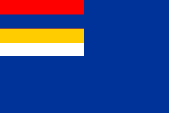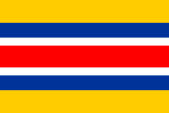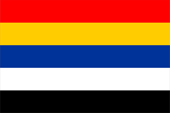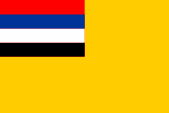mobile View, to the German Version tap the flag


- Mengjiang
- 1936–1945 existing Japanese satellite state in the Inner Mongolia
- own names:
Mongolian: Üwür Mongol
Chinese: Nei Menggu, Nei Mengguo, Nei Monggol
• Flags
• Meaning/Origin of the Flag
• Numbers and Facts
• History
• Origin of the Country's Name

1936–1937,
National flag,
Source, by:
World Statesmen




1937–1939,
National flag,
Source, by:
World Statesmen




1939–1945,
National flag,
Source, by:
World Statesmen




The flags of Mengjiang have been combinations of red, blue, white and yellow. Probably represented the colors, similar to the colors of the Republic of China (1912–1928) or the colors of Manchukuo, various nationalities. Compared to China, they have omitted black, probably because there are no Tibetans in Inner Mongolia.


The flag of the Republic of China showed five horizontal stripes, between 1912 and 1928, which should represent the five races of China (Han-Chinese, Manchou, Mongols, Hui & Turkestans abd Tibetans), and red – the colour of the Han – was positioned uppermost. In the Flag of Manchukuo the yellow stripe – the colour of the Manchou – was removed from the colour-sequence and inserted lowermost to make possible in this way the space for the large yellow area of the bunting. The three flag changes are possibly to explain in this way: When the State Mengjiang was founded by the Japanese, it was at first a principality. In 1939 took over the United Mengjiang Autonomous Government, and from 1941 the country was called Mongolian Autonomous State. Today's "Inner Mongolia Autonomous Region" does not have its own flag.
Source: Volker Preuß

Area: 171.042 square miles
Inhabitants: ca. 4 oder 5 Millions (estimated), thereof probably mostly Chinese, further Mongolians and Manchu
Capital: Kalgan (Zhangjiakou)
Languages: Chinese, Manchou, Korean, Japanese
Currency: Mengjiang Yuan
Time Zone, today: GMT + 8 h
Source:
Wikipedia (D)

11th to 12th cent. · Yin-Empire
1207–ca.1230 · conquest by the Mongols
1696 · Mongolia comes to China, Inner Mongolia (Southern Mongolia) is subjected to the Chinese administrative system directly, Outer Mongolia (northern Mongolia, Mongolia current state) remains loosely under Chinese sovereignty
1912 · overthrow of the monarchy in China, proclamation of the republic
1916–1928 · civil war in China
1933 · invasion of Japanese troops in the Chinese province of Chahar
1936 · Mongolian Prince Demchugdongrub forms a Japan-friendly military government
1937 · founding of the State of Mengjiang as satellite state of Japan under Demchugdongrub
1939 · takeover by the United Mengjiang Autonomous Government
August/September 1945 · Soviet and Mongol troops invade Mengjiang and left it under the rule of the Chinese Communists
1945–1951 · civil war in China (the National-Chinese government of the Guomindang against communist partisans)
1947 · Foundation of Inner Mongolia Autonomous Region, consisting of two provinces
1st of October 1949 · proclamation of the People's Republic of China (including Inner Mongolia) by the superior communist partisans which meanwhile control the largest part of China
1955 · Enlargement of the territory of Autonomous Inner Mongolia
1969 · drastic reduction of the territory of Autonomous Inner Mongolia
Source:
Atlas zur Geschichte,
Wikipedia (D),
World Statesmen

The name "Mengjiang" comes from the Chinese "Meng Chiang", which literally means "Mongolian border". "Inner Mongolia" (Southern Mongolia) became in the 18th century directly subjected under the Chinese administrative system, Outer Mongolia (northern Mongolia, Mongolia current state) remained loosely under Chinese sovereignty.
Source: Wikipedia (D)


![]()






